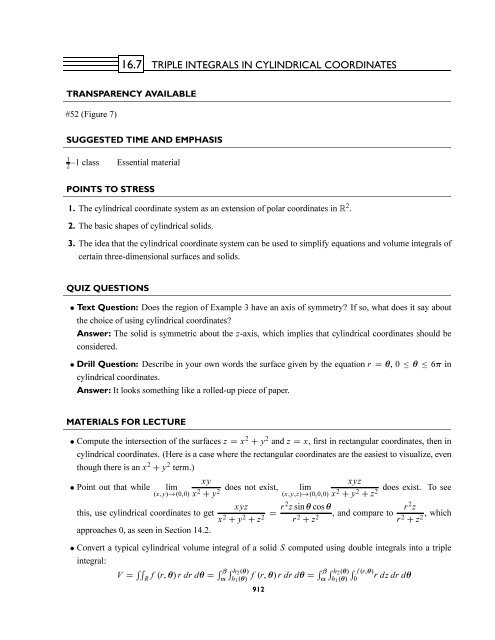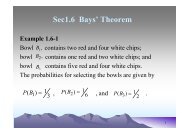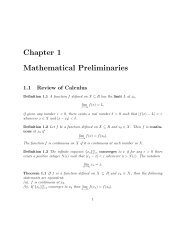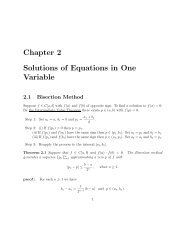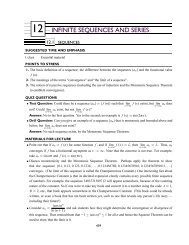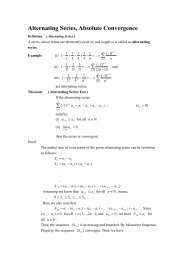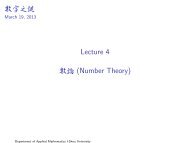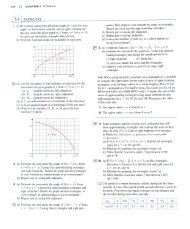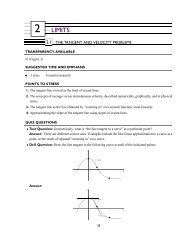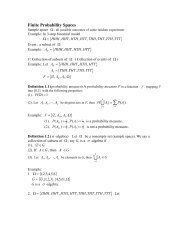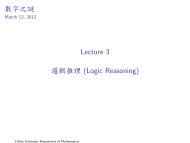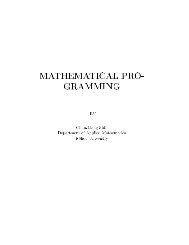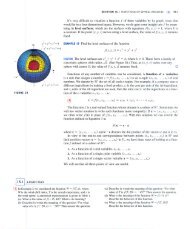16 MULTIPLE INTEGRALS
16 MULTIPLE INTEGRALS
16 MULTIPLE INTEGRALS
Create successful ePaper yourself
Turn your PDF publications into a flip-book with our unique Google optimized e-Paper software.
<strong>16</strong>.7 TRIPLE <strong>INTEGRALS</strong> IN CYLINDRICAL COORDINATES<br />
TRANSPARENCY AVAILABLE<br />
#52 (Figure 7)<br />
SUGGESTED TIME AND EMPHASIS<br />
1<br />
2<br />
–1 class Essential material<br />
POINTS TO STRESS<br />
1. The cylindrical coordinate system as an extension of polar coordinates in R 2 .<br />
2. The basic shapes of cylindrical solids.<br />
3. The idea that the cylindrical coordinate system can be used to simplify equations and volume integrals of<br />
certain three-dimensional surfaces and solids.<br />
QUIZ QUESTIONS<br />
• Text Question: Does the region of Example 3 have an axis of symmetry? If so, what does it say about<br />
the choice of using cylindrical coordinates?<br />
Answer: The solid is symmetric about the z-axis, which implies that cylindrical coordinates should be<br />
considered.<br />
• Drill Question: Describe in your own words the surface given by the equation r = θ, 0≤ θ ≤ 6π in<br />
cylindrical coordinates.<br />
Answer: It looks something like a rolled-up piece of paper.<br />
MATERIALS FOR LECTURE<br />
• Compute the intersection of the surfaces z = x 2 + y 2 and z = x, first in rectangular coordinates, then in<br />
cylindrical coordinates. (Here is a case where the rectangular coordinates are the easiest to visualize, even<br />
though there is an x 2 + y 2 term.)<br />
• Point out that while<br />
lim<br />
(x,y)→(0,0)<br />
this, use cylindrical coordinates to get<br />
approaches 0, as seen in Section 14.2.<br />
xy<br />
x 2 does not exist,<br />
+ y2 lim<br />
(x,y,z)→(0,0,0)<br />
xyz<br />
x 2 + y 2 does exist. To see<br />
+ z2 xyz<br />
x 2 + y 2 + z 2 = r2 z sin θ cos θ<br />
r 2 + z 2 , and compare to<br />
r 2 z<br />
r 2 + z 2 ,which<br />
• Convert a typical cylindrical volume integral of a solid S computed using double integrals into a triple<br />
integral:<br />
V = ∫∫ R f (r, θ) rdrdθ = ∫ β∫ h2 (θ)<br />
α h 1 (θ) f (r, θ) rdrdθ = ∫ β∫ h2 (θ) ∫ f (r,θ)<br />
α h 1 (θ) 0<br />
rdzdrdθ<br />
912


